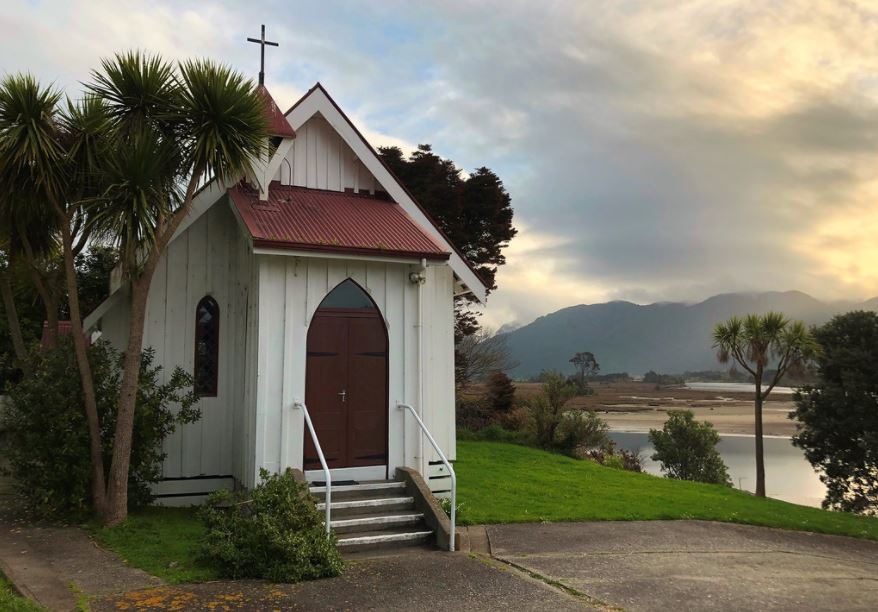The following text was prepared as part of an upgrade project and was completed 28 Feb 2003: Overlooking the Aorere River is St Cuthbert's Church, designed by renowned surveyor and explorer Thomas Brunner (1821-1874), and built in 1873 to serve the small mining community of Collingwood. Now the oldest remaining building in Collingwood, it was the first and only purpose-built church erected after the whare that had served Anglican Maori from Tomatea Pa from 1843. Until the late 1850s, Collingwood was ministered by travelling missionaries. In 1857 gold was discovered in the Aorere Valley and the town of Collingwood swelled with an influx of miners. Concerned that the crowded area was without permanent religious ministration, the first Bishop of Nelson, Edmund Hobhouse (1817-1904), appointed his former curate, the Reverend R. H. Codrington, to the Golden Bay goldfields. Codrington, who later became a prominent scholar in Melanesian languages, advocated for the erection of a permanent church and acquired the land on which St Cuthbert's Church now stands. Despite the establishment of a building fund by Codrington's successor Reverend Halcombe, the gold rush was short lived and little progress was made on the church. Halcombe learned Te Reo Maori and held services in the whare and schoolhouse. The next vicar Reverend Richard Gaskin, considered a new church to be essential. His death by drowning in 1872 inspired the community to complete the church out of respect for his memory. Thomas Brunner, who had trained in Oxford, England as an architect and surveyor, designed St Cuthbert's Church shortly before his death in 1874. It was the second church Brunner had designed. However, Brunner is best remembered for his epic explorations into the Nelson region and the West Coast in the 1840s, for which he was awarded a medal from the Royal Geographical Society in 1850. Built of pit-sawn timber in the English Gothic style that has inspired the design of churches throughout New Zealand, St Cuthbert's Church is a simple, lean-to structure with a small turret bell tower that holds the first bell to be cast in Nelson. The church is based on a simple rectangular plan, although two small bays project from each side of the nave and add interest to the building. The lancet windows at the west end of the church and trefoils on the side walls were donated by the then Bishop of Nelson, Andrew Suter. The steeply pitched roof was covered with shingles that remain underneath their modern, corrugated iron covering. The interior features exposed timber framing. Constructed by a Mr Grange for £140, St Cuthbert's was described as 'one of the best-built churches in the diocese' upon its completion in 1873. The opening of the church was delayed by the discovery that Bishop Suter had inaccurately surveyed the land on which the church stood and the congregation's desire to reduce the £90 debt on the building. Although no records of the dedication have been found, it is believed that St Cuthbert's was opened before the end of 1873. The church remains close to its original condition and, despite the removal of the vicar to the larger settlement of Takaka in 1973, St Cuthbert's continues to be the focal point of the Anglican community in Collingwood. St Cuthbert's Church has national significance as a rare example of the architectural skill of Thomas Brunner and the building stands as a memorial to this important surveyor. It is of historical interest for its intimate association with people responsible for the widespread development and strengthening of the Anglican Church in New Zealand and is a reflection of the progress made in the Golden Bay area. St Cuthbert's has technological importance as an example of early timber construction. As the custodian of the first bell cast in Nelson, it reflects the development of industry in the region. It has strong spiritual significance as an enduring place of worship and is a continuing symbol of the Anglican Church in Collingwood. The church is also related to the gold rushes that were a phenomenon of late nineteenth century New Zealand and, as such, provides insight into the ancillary activities that accompanied gold mining. It dates from early period of New Zealand history and, as the oldest building remaining in Collingwood, is of considerable local value.



Location
List Entry Information
Overview
Detailed List Entry
Status
Listed
List Entry Status
Historic Place Category 1
Access
Private/No Public Access
List Number
1626
Date Entered
2nd February 1991
Date of Effect
2nd February 1991
City/District Council
Tasman District
Region
Tasman Region
Legal description
Lot 1 DP 18207 (RT NL12A/928), Nelson Land District
Stay up to date with Heritage this month
